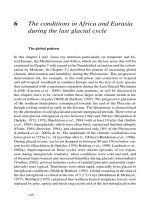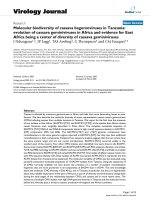The conditions in Africa and Eurasia during the last glacial cycle
Bạn đang xem bản rút gọn của tài liệu. Xem và tải ngay bản đầy đủ của tài liệu tại đây (108.32 KB, 13 trang )
6 The conditions in Africa and Eurasia
during the last glacial cycle
The global pattern
In this chapter I will focus my attention particularly on temperate and bo-
real Europe, the Mediterranean and Africa, which are the key areas that will be
examined in Chapter 7 with regard to the Neanderthal extinction and the coloni-
sation by Moderns. In Chapter 3 I described the pattern of increasing global
climatic deterioration and instability during the Pleistocene. This progressive
deterioration led, for example, to the contraction and extinction of tropical
and sub-tropical woodland in southern Europe and to the rise of xeric species
that culminated with a maximum expansion during the Last Glacial Maximum
(LGM) (Carrion et al., 2000). Smaller scale patterns, as will be discussed in
this chapter, have to be viewed within these larger-scale climate trends at the
scale of millions of years (Webb & Bartlein, 1992). The progressive glaciation
of the northern hemisphere commenced towards the end of the Pliocene al-
though cooling started as early as the Eocene. The Quaternary is characterised
by the alternation of cold glacial and warmer interglacial periods. There were at
least nine glacial–interglacial cycles between 2 Myr and 700 kyr (Shackleton &
Opdyke, 1973, 1976; Shackleton et al., 1984) with at least 10 after that (Imbrie
et al., 1984). Interglacials, which were often brief, started and finished abruptly
(Flohn, 1984; Broecker, 1984), and characterised only 10% of the Pleistocene
(Lambeck et al., 2002a & b). The amplitude of the climatic oscillations was
lower prior to 735 kyr (c. 41 kyr) than after (c. 100 kyr) (Ruddiman et al., 1986).
During glacial events, sea levels dropped to between 90 and 130 m below cur-
rent levels (Shackleton & Opdyke, 1976; Rohling et al., 1998; Lambeck et al.,
2002a). Superimposed on these cycles were shorter episodes of ice expan-
sion during interglacials (stadials), when conditions were cold and arid, and
of thermal improvement and increased humidity during glacials (interstadials)
(Voelker, 2002); at lower latitudes cycles of rainfall (pluvials) and aridity (inter-
pluvials) were typical. Transitions were often rapid, especially from glacial to
interglacial conditions (Webb & Bartlein, 1992). Global warming at the start of
the last interglacial occurred at the rate of 5.2
◦
C/1 kyr (Ruddiman & McIntyre,
1977). Woillard (1979) calculated that northern French temperate forests were
replaced by pine, spruce and birch taiga at the end of the last interglacial in the
135
136 Neanderthals and Modern Humans
space of between 75 and 225 years. Dansgaard et al. (1989) have shown that
temperatures rose by 7
◦
C in 50 years at the end of the last glaciation. Stuiver &
Grootes (2000) record 13 cold–warm transitions in the period 60–10 kyr that
took 50 years to complete, the initial response being very fast with only a few
years being required to reach the mid-point.
In this chapter I focus on the last glacial cycle (125–0 kyr) that has been the
coolest and most variable period and that which saw the arrival of Moderns
into Eurasia and the extinction of the Neanderthals. It was characterised by
the climate variations that were typical of the late Pleistocene, being greatest
in amplitude and severity during glacial maxima (Oppo et al., 1998) when
atmospheric circulation was most turbulent (Ditlevsen et al., 1996). The last
glacial cycle was characterised by the melt of Oxygen Isotope Stage (OIS) 6
ice around 130 kyr, followed by a brief interglacial (OIS 5e) and a subsequent
gradual climatic deterioration at OIS 4 (the ice sheet being smaller than in
the LGM). This was followed by a long drawn ice withdrawal ahead of the
LGM in OIS 2 (van Andel & Tzedakis, 1996) when winter sea ice extended
south to the French coast (COHMAP, 1988). The intermediate OIS 3 (60–
25 kyr) is characterised by many climate changes at millennial scales, with
cold periods that approached conditions at the LGM and warm intervals with
temperatures just below Holocene values (Barron & Pollard, 2002). Large areas
of Fennoscandia were, however, ice-free as the Scandinavian Ice Sheet was
much reduced in comparison with OIS 2 (Ukkonen et al., 1999; Arnold et al.,
2002).
Global climate has also fluctuated repeatedly and frequently even within
glacials and interglacials (van Andel & Tzedakis, 1996; Nimmergut et al., 1999;
Watts et al., 2000) although the degree of climatic variability of the last inter-
glacial is disputed (Kukla, 1997, 2000; Kukla et al., 1997; Cheddadi et al., 1998;
Frogley et al., 1999; Rose et al., 1999; Boettger et al., 2000). OIS 4 appears
to have been more climatically diverse than had been recognised and included
interstadial conditions (Watts et al., 2000). The GRIP ice core data (Dansgaard
et al., 1993; GRIP, 1993) reveals 20 warm events in the time period 105–20 kyr.
Such large and abrupt, high frequency, climate changes seem to have occurred
globally at annual, decadal, centennial and millennial intervals (Bond et al.,
1997; Allen et al., 1999; Alley et al., 1999; Alley, 2000; Stuiver & Grootes,
2000; Elliot et al., 2002; Helmke et al., 2002; Voelker, 2002), particularly during
OIS 3 (van Andel & Tzedakis, 1996). The Dansgaard–Oeschger (DO) temper-
ature oscillations (Dansgaard et al., 1993) are the dominant millennial-scale
climate-change signal and are associated with the alternation between warm
times and glacial maxima and stadials in the North Atlantic (Alley et al., 1999).
Heinrich Events (HE) are less frequent and are the result of massive ice dis-
charges into the North Atlantic related to the surging of the Laurentide Ice Sheet
Africa and Eurasia during the last glacial cycle 137
through the Hudson Strait (Heinrich, 1988; Bond & Lotti, 1995; Alley et al.,
1999). There were, additionally, brief warm events such as Oerel (58–54 kyr),
Glinde (51–48 kyr), Hengelo (39–36 kyr) and Denekamp (32–28 kyr) intervals.
These oscillations caused repeated advances of forest and open vegetation in
Europe and the Mediterranean and of Mediterranean forest and semi-desert in
north-west Africa (van Andel & Tzedakis, 1996).
Environmental change, indicated by vegetation dynamics, not only reflects
responses to global events translated into local climatic changes but is also a
function of the available pool of plant taxa, thus creating spatial and temporal
heterogeneities of response (Tzedakis, 1994; Vandenberghe et al., 1998). For
example, Gibraltar is a coastal site that is separated from the interior by high
coastal ranges. Here cooling is reflected by the presence of montane black pines
Pinus nigra (Finlayson & Giles Pacheco, 2000) and not by the presence of the
open vegetation that characterises inland sites (Carri´on, et al., 1998). Chance
changes in the location of plant glacial refuges are critical in the subsequent
recolonisation of adjacent areas during interglacials (Reille & Beaulieu, 1995).
Time lags are also crucial in the interpretation of data. Care has to be exercised
when applying terrestrial data to the marine record. Such assumptions may
be valid in the case of transitions from glacial to interglacial conditions that
are rapid and large scale. Interglacial to glacial transitions are, however, more
diffuse because ice-sheet growth is slower than ice-sheet decay. In such cases
vegetation may respond differently and at different rates leading to time lags
between vegetation and climatic variables (Tzedakis, 1994; Coope, 2002). Time
lags are not only important in the case of vegetation change. Faunal patterns,
including those of humans, are also subject to time lags and this can cause con-
fusion and misinterpretation of cause and effect, particularly at small temporal
scales. Direct correlations of faunal patterns to climate signals from the marine
isotope record therefore need to be addressed with caution.
Sea-level changes in the Quaternary have been the result of the growth and
decay of the ice sheets. Sea-level lowstands are associated with glaciations and
highstands with interglacials. The global picture is of a rapid rise in sea-levels,
due to an exceptionally fast OIS 6 deglaciation, of the order of 20 m per 1 kyr to
a highstand during OIS 5e with sea-levels between 2 and 12 m above the present
(van Andel & Tzedakis, 1996). This was followed by a variable but progressive
drop in sea-levels to the LGM lowstand of between −118 and −135 m (Clark &
Mix, 2002), levels oscillating around −80 m during OIS 3 (Barron & Pollard,
2002) and falling rapidly from around 30 kyr with a sharp subsequent rise to
the Holocene highstand (van Andel & Tzedakis, 1996). Prior to the LGM there
were significant and rapid sea-level fluctuations of the order of 10 to 15 m
every 6 kyr, coinciding with Heinrich ice-rafting events (Lambeck & Chappell,
2001). There were then two major periods of rapid and sustained sea-level rise
138 Neanderthals and Modern Humans
(16–12.5 kyr and 11.5–8 kyr) at a rate of 15 m per 1 kyr (Lambeck & Chappell,
2001).
Superimposed on the global signals are regional and local changes that have
been caused by uplift and subsidence of the coastal zone or by regional and
local climate effects. Climatic, meteorological and tidal-driven changes are
particularly important at decadal, annual and even smaller scales and may lead to
significantly different patterns even between proximate locations (Lambeck &
Chappell, 2001).
Temperate and boreal Europe: the Eurasian Plain
The colonisation by trees of the Eurasian Plain during interglacials reflected
differences in source areas of individual species, different rates of migration and
also in the nature of the climatic signal so that the broad-leaved forest succession
varied regionally and between different interglacials (Zagwijn, 1992). In the
last interglacial (OIS 5e) much of Europe was covered by temperate mixed oak
forest (Vandenberghe et al., 1998; Turner, 2002; Kukla et al., 2002) contrasting
with the great reduction of forest and replacement by treeless vegetation types
during glacials (Reille et al., 2000; Kukla et al., 2002). This was an oceanic
interglacial, a rare form that only occupied 12% of the time span of the last
500 kyr and was characterised by a constant succession in the expansion of
elm Ulmus, oak Quercus,hazel Corylus,yewTaxus and hornbeam Carpinus
followed by fir Abies, spruce Picea and pine Pinus. Tree response was less
intense during continental warm episodes (Zagwijn, 1992).
In contrast, at the height of the LGM (OIS 2) in Europe, around 20 kyr,
glaciers covered around two-thirds of the British Isles, Scandinavia, the Baltic
and the Alps. Much of the remainder of Europe north of the Mediterranean had
a cover of permafrost (CLIMAP, 1976; Maarleveld, 1976). Away from the ice
sheets the vegetation cover was sparse with large areas of bare ground and an
unusual mixed flora (Birks, 1986; Zagwijn, 1992). Much of Europe was a polar
desert with varying local conditions of geology, soil, relief and microclimate
contributing towards variations in the local flora. The ice sheets were even more
extensive and persisted longer during the cold phase (OIS 6) preceding the last
interglacial (OIS 5e) (van Andel & Tzedakis, 1996).
The situation during OIS 3 suggests that, even in oceanic temperate areas
such as Britain, mean July temperatures between 40 and 25 kyr were close to
10
◦
C (temperatures that limit tree growth) and winter temperatures were low,
around −20
◦
C. These estimates are based on the presence of cold, tundra,
insects in British deposits, including a number of species that are currently
restricted to east Asia and indicate that a treeless landscape with a tundra flora
Africa and Eurasia during the last glacial cycle 139
and fauna predominated (Coope, 2002). Evidence from other sites across the
North European Plain indicates that a uniform climate extended across much of
this region at the time. The vegetation of the Eurasian Plain during OIS 3, in the
west at least, seems to have oscillated between conifer woodland, with shrub
tundra in the north, during warm parts of the cycle and a tundra and cold steppe
mosaic, with polar desert in the north, during the coldest moments (van Andel &
Tzedakis, 1996). Coope (2002) proposed three modes for the OIS 3 climate of
north-western Europe: (1) a brief period between 43 and 42 kyr of temperate
and oceanic conditions, with similar temperatures to today but an absence of
trees in the landscape; (2) a series of interstadials between 40 and 25 kyr with
cold continental conditions as described above; and (3) periods of intense cold
between the interstadials during which biological systems were reduced to a
minimum or inhibited altogether.
Further east, on the Russian Plain, the dense temperate forest of the last
interglacial maximum was replaced by open, harsh, loess-steppe with the onset
of the LGM (Rousseau et al., 2001). The latter part of OIS 3 is characterised
by decreasing temperature, increasing aridity and continentality (Soffer, 1985).
Extremely cold temperatures, aridity and permafrost characterised large parts.
The vegetation was a unique tundra-grassland with sparse arboreal vegetation
(pine, beech, oak) in the form of gallery forests along river valleys (Soffer,
1985). Conditions improved in relative terms between 33 and 24 kyr during the
Briansk Interstadial before the onset of full glacial conditions (Soffer, 1985;
Markova et al., 2002). Tundra, forest–tundra and tundra–steppe were widely
distributed across the Russian Plain during the Briansk Interstadial with the
southern limit of the range of a number of Arctic plants being 1200 km further
south than today (and a further 600 km during OIS 2). Steppe and forest–steppe
predominated in the south, for example around the Black Sea. In the south, the
added topographical heterogeneity (e.g. in Crimea) increased the diversity of
vegetation types (Markova et al., 2002). Climatic improvement is also detected
in northern Siberia from 48–25 kyr, with open larch forest with Alnus fruticosa
and Betula nana in the Taymyr Peninsula (Andreev et al., 2002).
In contrast to the northward migration of trees during warm episodes the ef-
fect of glacials was the extinction of trees except within glacial refugia (Willis,
1996; Tzedakis et al., 2002). By around 13 kyr thermal conditions had improved
in north-western Europe and the tundra and steppe were gradually replaced by
boreal woodland and then by spruce forest and by birch–conifer woodland
(Huntley & Birks, 1983). The cold Younger Dryas Stadial (11–10 kyr) repre-
sented a further deterioration of conditions with tundra once again stretching
from southern Sweden to much of France and the British Isles (Huntley & Birks,
1983). The rapid amelioration leading to the present interglacial (the Holocene)
followed after 10 kyr bp. These changes are reflected in sites with long pollen









